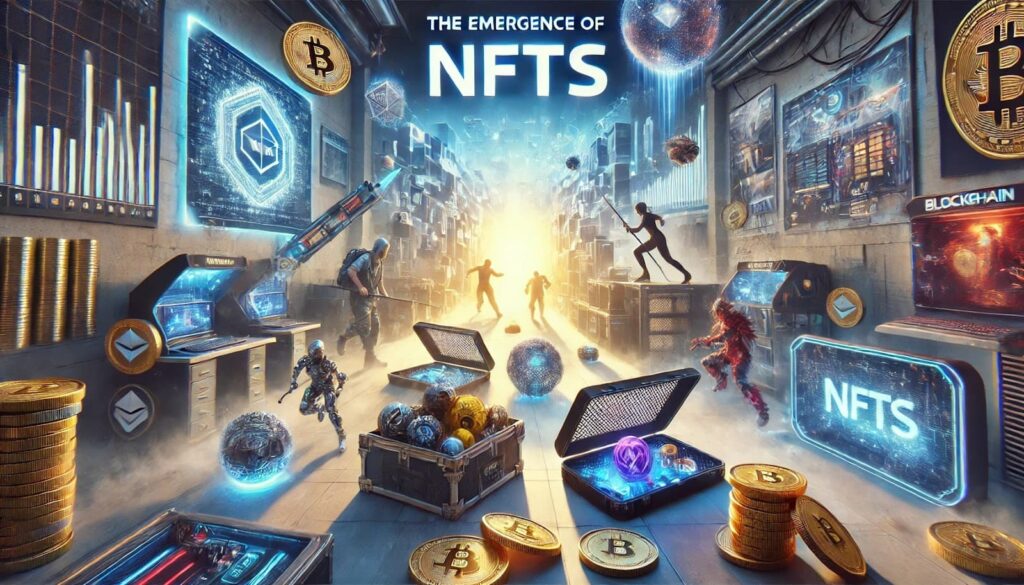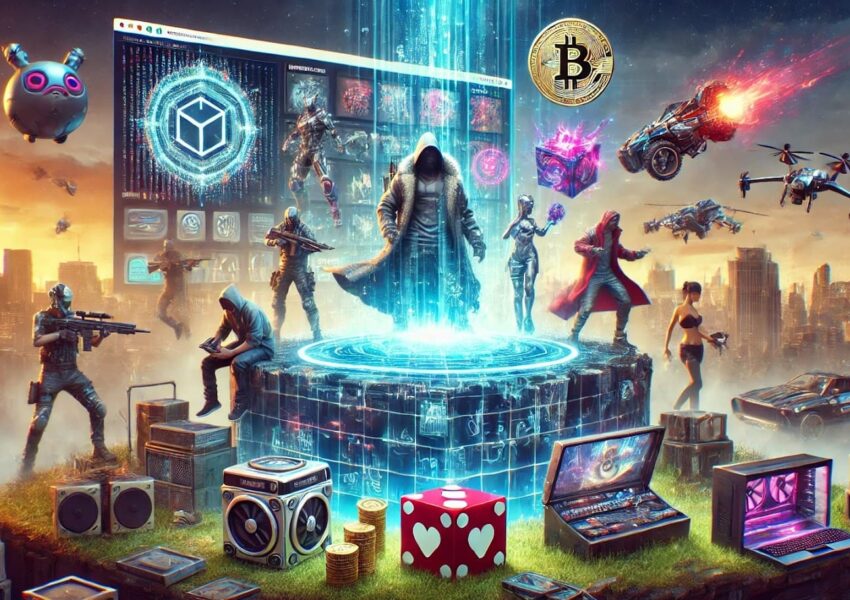The trading of skins, in-game items, and NFTs has rapidly become a key part of the gaming ecosystem, transforming the way players interact with digital assets. These items, once just aesthetic additions to a player’s inventory, have evolved into valuable commodities that can be traded across platforms and marketplaces. Skins and in-game items have long been part of games like CS:GO and Fortnite, where players have traded rare items for real-world money. With the introduction of Non-Fungible Tokens (NFTs), this landscape has shifted dramatically. NFTs offer a new level of ownership and scarcity, providing players with unique digital assets that are verifiably owned and tradeable. The appeal of trading these assets lies not only in the potential to earn money but also in the opportunity for players to personalize their gaming experience with one-of-a-kind items. The future of game assets seems poised to expand further with NFTs, enhancing both the economic and social aspects of gaming.
As we look toward the future, the intersection of blockchain technology and gaming assets will likely reshape the industry. With NFTs becoming increasingly integrated into game economies, we may see the emergence of fully decentralized gaming ecosystems. This would allow for smoother, peer-to-peer trading of assets without the need for intermediaries. Players could create and sell their own in-game items as NFTs, further driving the creativity and economic potential within gaming. Moreover, platforms that support such transactions, like Exness ID, will play a crucial role in providing secure and transparent environments for trading. As the gaming community continues to embrace digital ownership, the line between virtual and real-world economies will blur, leading to new opportunities for both developers and players alike.
Definition of Trading Skins, Items, NFTs
Trading Skins refers to the exchange of cosmetic items, typically character or weapon skins, in video games. These skins alter the appearance of in-game assets without affecting gameplay functionality. In many popular games like CS:GO and Fortnite, skins can be earned, purchased, or traded between players. Their value is often determined by rarity, demand, and their aesthetic appeal. While skins have no direct impact on gameplay, they allow players to personalize their experience and showcase their collection in the game.
Trading Items involves the exchange of in-game items that can have various functions, such as weapons, tools, or resources. These items are integral to the gameplay, providing players with advantages or enhancing their gaming experience. Unlike skins, items often have a direct impact on game mechanics, making them more valuable. Items can be traded through game marketplaces or between players, and in some cases, they can be sold for real money, creating a virtual economy within the game world.
NFTs (Non-Fungible Tokens) are unique digital assets verified on a blockchain. Unlike tradable skins or items, NFTs offer true ownership of digital goods that cannot be replicated or replaced by another item. Each NFT is distinct and can represent anything from a collectible in a game to art, music, or even land within virtual worlds. In gaming, NFTs allow players to own, buy, sell, and trade in-game items with verified scarcity and ownership. They have gained significant attention for their potential to change how game assets are traded, providing players with new ways to engage with digital economies.
| Aspect | Skins | In-Game Items | NFTs |
| Functionality | Cosmetic only | Functional, may affect gameplay | Varies: cosmetic or functional depending on the game or platform |
| Ownership | Often licensed, not truly owned | Limited ownership within the game | True digital ownership via blockchain |
| Tradability | Yes, usually on in-game or third-party marketplaces | Yes, through in-game trading or external markets | Yes, peer-to-peer trading on decentralized platforms |
| Uniqueness | Often mass-produced with varying rarity levels | Common, rare, or unique based on game design | Each NFT is unique and verifiable on the blockchain |
| Monetization | Can be sold for in-game currency or real money | Sometimes sellable for real-world value | Easily sellable, often with value fluctuation based on demand |
| Examples | CS:GO weapon skins, Fortnite outfits | Minecraft tools, Diablo weapons, WoW gear | Axie Infinity creatures, land in Decentraland, weapons in Illuvium |
| Value Drivers | Rarity, visual design, community demand | Utility in-game, rarity, and power | Rarity, utility, creator reputation, and blockchain provenance |
| Security | Moderately secure, tied to game accounts | Depends on the game platform | High security with ownership recorded on blockchain |
| Interoperability | Limited to one game | Usually game-specific | Can be used across different games and platforms (if supported) |
| Resale Platforms | Steam Market, SkinBaron, etc. | In-game auction houses, secondary marketplaces | OpenSea, Rarible, Immutable X |
The Emergence of NFTs in Gaming
The emergence of NFTs (Non-Fungible Tokens) in gaming marks a revolutionary shift in how digital assets are owned, traded, and experienced by players. Traditionally, in-game items, skins, and collectibles were owned and controlled by the game developers, limiting players’ ability to truly own or trade their digital possessions outside of the game environment. However, with the advent of blockchain technology, NFTs have introduced a new paradigm where players can possess unique, verifiable, and transferable digital assets. Each NFT is tied to a specific item or asset, such as a rare skin, weapon, or virtual property, and is stored on a blockchain, ensuring its authenticity and scarcity.
In the context of gaming, NFTs allow players to buy, sell, and trade in-game assets on decentralized marketplaces, offering a level of ownership that was previously unavailable. Games like Axie Infinity and Decentraland have pioneered the use of NFTs, where players can earn, collect, and trade NFTs as part of their gaming experience. Unlike traditional in-game items that can be copied or replicated, NFTs are unique and cannot be replaced, making them valuable assets. This new approach to gaming not only provides players with the opportunity to profit from their digital assets but also opens up new avenues for creative expression within virtual worlds. As the gaming industry continues to embrace NFTs, we are likely to see even more innovative uses of blockchain technology to enhance the player experience and create new economic models for the gaming community.

Benefits of Trading Game Assets
Trading game assets offers several key benefits for both players and the gaming industry as a whole:
- Economic Opportunities for Players: One of the most significant benefits is the potential for players to earn money by trading game assets. Rare skins, items, and NFTs can be sold for real-world currency, creating an entirely new avenue for players to monetize their time and effort in games. NFTs, in particular, have introduced the possibility of assets appreciating in value, allowing players to make profitable investments.
- Enhanced Player Engagement: The ability to trade, buy, and sell in-game assets adds a layer of depth and excitement to gameplay. Players are motivated to engage more with the game, whether by collecting rare items, hunting for valuable skins, or participating in a dynamic economy. This increased engagement can help keep players interested in the game for a longer period, boosting retention.
- True Ownership and Control: NFTs give players true ownership of their digital assets. Unlike traditional in-game items, which are often tied to a player’s account and controlled by the game developers, NFTs can be bought, sold, or transferred across platforms. This level of ownership offers players more control over their assets and allows for more freedom in how they use or trade their items.
- Building Community and Social Connections: Trading in-game assets fosters a sense of community among players. By participating in marketplaces or trading with others, players interact and form relationships based on shared interests. This social aspect can enhance the overall gaming experience and create a more dynamic, interconnected community.
- Increased Game Longevity: When players can buy and sell items or skins, it creates an evolving market within the game. This ongoing economic activity helps to keep the game alive and relevant over time. Developers can also benefit from this by introducing new items or assets that add value to the game’s virtual economy, ensuring its continued success.
The Future Types of Game Asset Trading
The future of game asset trading is set to be shaped by innovations in technology, particularly blockchain and NFT integration, which will offer new types of trading experiences for players. Here are some of the potential future types of game asset trading:
Cross-Game Asset Trading:
In the future, players may be able to trade assets not just within a single game but across multiple games and platforms. With blockchain technology and NFTs, assets can be universally recognized and transferable, allowing players to use the same skins, items, or virtual assets across different gaming universes. For example, a rare skin obtained in one game could be used in another, creating a new level of interoperability between games and further blurring the lines between virtual worlds.
Player-Generated Content Marketplaces:
As games evolve, developers may offer platforms where players can create, trade, and monetize their own in-game assets. These could include unique skins, characters, or even new game levels. With the rise of NFTs, players could potentially sell their creations in secure, decentralized marketplaces. This would give players more creative control while generating additional revenue streams for developers and players alike.
Decentralized Virtual Economies:
The future of game asset trading could see the rise of entirely decentralized virtual economies, where players control the entire trading ecosystem. These decentralized platforms would be run by players and supported by blockchain networks, removing the need for centralized exchanges or in-game markets controlled by developers. This would empower players to set the prices, buy and sell directly, and even create their own virtual economies within games.
Fractionalized Asset Ownership:
NFTs are likely to be the foundation for fractionalized ownership of in-game assets in the future. Rather than having one player own an entire asset (like a rare sword or collectible skin), fractional ownership could allow multiple players to collectively own a portion of an asset. This would create new opportunities for players to invest in high-value items that might otherwise be out of their reach and allow for more flexible trading models.
Integrated Real-World and Virtual Asset Trading:
As the lines between real and virtual economies continue to blur, future game asset trading could involve direct integration with real-world currencies and financial systems. Players may be able to trade in-game items for cryptocurrency or even traditional currency, linking virtual economies with real-world financial markets. Such developments would enable players to convert their in-game wealth into tangible value outside the game.
AI and Smart Contracts for Asset Management:
The use of artificial intelligence and smart contracts could automate many aspects of asset trading. AI could be used to predict market trends, determine the value of assets, and even suggest trades to players based on their gaming habits. Smart contracts would facilitate secure, automated transactions, ensuring that trades are executed seamlessly without the need for intermediaries, reducing costs and enhancing security.
Conclusion
The trading of skins, items, and NFTs has the potential to revolutionize the gaming industry, transforming how players interact with virtual assets and how the gaming economy functions. NFTs, in particular, offer players true ownership and the ability to trade digital assets across platforms and games, providing a new layer of value and security. As technology evolves, the future will likely see even more advanced and interconnected trading models, such as cross-game asset trading, decentralized economies, and fractional ownership. These developments not only open new revenue streams for players but also enhance player engagement and foster deeper connections within gaming communities. As we move forward, the integration of blockchain and NFTs in gaming will continue to shape the future of digital ownership, offering endless possibilities for both players and developers in creating more immersive, dynamic, and profitable gaming experiences.


